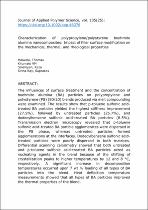 ResearchSpace
ResearchSpace
Characterization of polypropylene/polystyrene boehmite alumina nanocomposites: Impact of filler surface modification on the mechanical, thermal, and rheological properties
JavaScript is disabled for your browser. Some features of this site may not work without it.
- ResearchSpace
- →
- Research Publications/Outputs
- →
- Journal Articles
- →
- View Item
| dc.contributor.author |
Malwela, Thomas

|
|
| dc.contributor.author |
Khumalo, VM

|
|
| dc.contributor.author |
Salehiyan, Reza

|
|
| dc.contributor.author |
Ray, Suprakas S

|
|
| dc.date.accessioned | 2019-02-04T06:43:48Z | |
| dc.date.available | 2019-02-04T06:43:48Z | |
| dc.date.issued | 2018-07 | |
| dc.identifier.citation | Malwela, T. et al. 2018. Characterization of polypropylene/polystyrene boehmite alumina nanocomposites: Impact of filler surface modification on the mechanical, thermal, and rheological properties. Journal of Applied Polymer Science, vol. 135(25): https://doi.org/10.1002/app.46376 | en_US |
| dc.identifier.issn | 0021-8995 | |
| dc.identifier.issn | 1097-4628 | |
| dc.identifier.uri | https://onlinelibrary.wiley.com/doi/abs/10.1002/app.46376 | |
| dc.identifier.uri | https://doi.org/10.1002/app.46376 | |
| dc.identifier.uri | http://hdl.handle.net/10204/10674 | |
| dc.description | Copyright: 2018 Wiley. Due to copyright restrictions, the attached PDF file only contains the abstract of the full text item. For access to the full text item, please consult the publisher's website. The definitive version of the work can be obtained via https://onlinelibrary.wiley.com/doi/abs/10.1002/app.46376 | en_US |
| dc.description.abstract | The influences of surface treatment and the concentration of boehmite alumina (BA) particles on polypropylene and polystyrene (PS) (80/20) blends produced via melt compounding were examined. The results show that p-toluene sulfonic acid-treated BA particles yielded the highest stiffness improvement (27.5%), followed by untreated particles (25.7%), and dodecylbenzene sulfonic acid-treated BA particles (8.5%). Transmission electron microscopy revealed that p-toluene sulfonic acid-treated BA particle agglomerates were dispersed in the PS phase, whereas untreated particles formed agglomerations at the interfaces. Dodecylbenzene sulfonic acid-treated particles were poorly dispersed in both matrices. Differential scanning calorimetry showed that both untreated and p-toluene sulfonic acid-treated BA particles acted as nucleating agents in the blend because of the shifting of crystallization peaks to higher temperatures by 12 and 8 °C, respectively. A significant increase in decomposition temperatures occurred upon 7 wt % loading of all types of BA particles into the blend. Heat deflection temperature measurements showed that all types of BA particles improved the thermal properties of the blend. | en_US |
| dc.language.iso | en | en_US |
| dc.publisher | Wiley | en_US |
| dc.relation.ispartofseries | Worklist;21479 | |
| dc.subject | Blends | en_US |
| dc.subject | Mechanical properties | en_US |
| dc.subject | Nanoparticles | en_US |
| dc.subject | Nanowires | en_US |
| dc.subject | Nanocrystals | en_US |
| dc.subject | Polyolefins | en_US |
| dc.subject | Surfactants | en_US |
| dc.title | Characterization of polypropylene/polystyrene boehmite alumina nanocomposites: Impact of filler surface modification on the mechanical, thermal, and rheological properties | en_US |
| dc.type | Article | en_US |
| dc.identifier.apacitation | Malwela, T., Khumalo, V., Salehiyan, R., & Ray, S. S. (2018). Characterization of polypropylene/polystyrene boehmite alumina nanocomposites: Impact of filler surface modification on the mechanical, thermal, and rheological properties. http://hdl.handle.net/10204/10674 | en_ZA |
| dc.identifier.chicagocitation | Malwela, Thomas, VM Khumalo, Reza Salehiyan, and Suprakas S Ray "Characterization of polypropylene/polystyrene boehmite alumina nanocomposites: Impact of filler surface modification on the mechanical, thermal, and rheological properties." (2018) http://hdl.handle.net/10204/10674 | en_ZA |
| dc.identifier.vancouvercitation | Malwela T, Khumalo V, Salehiyan R, Ray SS. Characterization of polypropylene/polystyrene boehmite alumina nanocomposites: Impact of filler surface modification on the mechanical, thermal, and rheological properties. 2018; http://hdl.handle.net/10204/10674. | en_ZA |
| dc.identifier.ris | TY - Article AU - Malwela, Thomas AU - Khumalo, VM AU - Salehiyan, Reza AU - Ray, Suprakas S AB - The influences of surface treatment and the concentration of boehmite alumina (BA) particles on polypropylene and polystyrene (PS) (80/20) blends produced via melt compounding were examined. The results show that p-toluene sulfonic acid-treated BA particles yielded the highest stiffness improvement (27.5%), followed by untreated particles (25.7%), and dodecylbenzene sulfonic acid-treated BA particles (8.5%). Transmission electron microscopy revealed that p-toluene sulfonic acid-treated BA particle agglomerates were dispersed in the PS phase, whereas untreated particles formed agglomerations at the interfaces. Dodecylbenzene sulfonic acid-treated particles were poorly dispersed in both matrices. Differential scanning calorimetry showed that both untreated and p-toluene sulfonic acid-treated BA particles acted as nucleating agents in the blend because of the shifting of crystallization peaks to higher temperatures by 12 and 8 °C, respectively. A significant increase in decomposition temperatures occurred upon 7 wt % loading of all types of BA particles into the blend. Heat deflection temperature measurements showed that all types of BA particles improved the thermal properties of the blend. DA - 2018-07 DB - ResearchSpace DP - CSIR KW - Blends KW - Mechanical properties KW - Nanoparticles KW - Nanowires KW - Nanocrystals KW - Polyolefins KW - Surfactants LK - https://researchspace.csir.co.za PY - 2018 SM - 0021-8995 SM - 1097-4628 T1 - Characterization of polypropylene/polystyrene boehmite alumina nanocomposites: Impact of filler surface modification on the mechanical, thermal, and rheological properties TI - Characterization of polypropylene/polystyrene boehmite alumina nanocomposites: Impact of filler surface modification on the mechanical, thermal, and rheological properties UR - http://hdl.handle.net/10204/10674 ER - | en_ZA |





